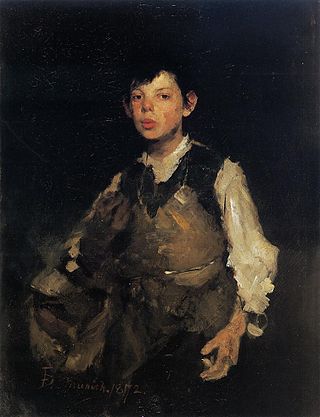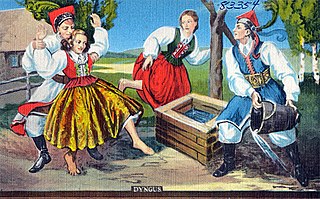
Easter eggs, also called Paschal eggs, are eggs that are decorated for the Christian holiday of Easter, which celebrates the resurrection of Jesus. As such, Easter eggs are commonly used during the season of Eastertide. The oldest tradition, which continues to be used in Central and Eastern Europe, is to dye and paint chicken eggs.
A tongue twister is a phrase that is designed to be difficult to articulate properly, and can be used as a type of spoken word game. Additionally, they can be used as exercises to improve pronunciation and fluency. Some tongue twisters produce results that are humorous when they are mispronounced, while others simply rely on the confusion and mistakes of the speaker for their amusement value.

The Easter Bunny is a folkloric figure and symbol of Easter, depicted as a rabbit—sometimes dressed with clothes—bringing Easter eggs. Originating among German Lutherans, the "Easter Hare" originally played the role of a judge, evaluating whether children were good or disobedient in behavior at the start of the season of Eastertide, similar to the "naughty or nice" list made by Santa Claus. As part of the legend, the creature carries colored eggs in its basket, as well as candy, and sometimes toys, to the homes of children. As such, the Easter Bunny again shows similarities to Santa and Christmas by bringing gifts to children on the night before a holiday. The custom was first mentioned in Georg Franck von Franckenau's De ovis paschalibus in 1682, referring to a German tradition of an Easter Hare bringing eggs for the children.
Alliteration is the repetition of syllable-initial consonant sounds between nearby words, or of syllable-initial vowels, if the syllables in question do not start with a consonant. It is often used as a literary device. An example is the quote "Out of doubt, out of dark to the day's rising" from Lord of the Rings.

The Junior Woodchucks of the World is a fictional scouting organization appearing in Disney comics and the DuckTales animated television franchise, most notably in adventures featuring Disney characters Huey, Dewey, and Louie as members.

The groundhog, also known as the woodchuck, is a rodent of the family Sciuridae, belonging to the group of large ground squirrels known as marmots. The groundhog is a lowland creature of North America; it is found through much of the Eastern United States, across Canada and into Alaska. It was first scientifically described by Carl Linnaeus in 1758.

Ēostre is a West Germanic spring goddess. The name is reflected in Old English: *Ēastre, Old High German: *Ôstara, and Old Saxon: *Āsteron. By way of the Germanic month bearing her name, she is the namesake of the festival of Easter in some languages. The Old English deity Ēostre is attested solely by Bede in his 8th-century work The Reckoning of Time, where Bede states that during Ēosturmōnaþ, pagan Anglo-Saxons had held feasts in Ēostre's honour, but that this tradition had died out by his time, replaced by the Christian Paschal month, a celebration of the resurrection of Jesus.

Whistling, without the use of an artificial whistle, is achieved by creating a small opening with one's lips, usually after applying moisture and then blowing or sucking air through the space. The air is moderated by the lips, curled tongue, teeth or fingers to create turbulence, and the curled tongue acts as a resonant chamber to enhance the resulting sound by acting as a type of Helmholtz resonator. By moving the various parts of the lips, fingers, tongue, and epiglottis, one can then manipulate the types of whistles produced.

Punxsutawney Phil is a groundhog residing in Young Township near Punxsutawney, Pennsylvania, who is the central figure in Punxsutawney's annual Groundhog Day celebration.

Fay Templeton was an American actress, singer, songwriter, and comedian.

Shita-kiri Suzume, translated literally into "Tongue-Cut Sparrow", is a traditional Japanese fable telling of a kind old man, his avaricious wife and an injured sparrow. The story explores the effects of greed, friendship and jealousy on the characters.

Groundhog Day is a tradition observed regionally in the United States and Canada on February 2 of every year. It derives from the Pennsylvania Dutch superstition that if a groundhog emerges from its burrow on this day and sees its shadow, it will retreat to its den and winter will go on for six more weeks; if it does not see its shadow, spring will arrive early. In 2024, an early spring was predicted.

Śmigus-dyngus or lany poniedziałek is a celebration held on Easter Monday across Central Europe, and in small parts of Eastern and Southern Europe. The tradition is widely associated with Poland and is observed by Polish Diaspora communities, particularly among Polish Americans who call it Dyngus Day.
Robert S. Roberts, sometimes referred to as "Ragtime" Bob Roberts, was an American novelty singer and ragtime song composer in the early years of the 20th century.

Cortana is a discontinued virtual assistant developed by Microsoft that used the Bing search engine to perform tasks such as setting reminders and answering questions for users.

Robert Hobart Davis (1869–1942) was a dramatist, journalist, and photographer from the U.S. He edited Munsey's Magazine from 1904 until 1925 and was a columnist for the New York Sun from 1925 to 1942 The New York Public Library has a collection of his papers. His photographs include portraits of prominent people.
"Peace" is a song by the American singer-songwriter Taylor Swift from her eighth studio album, Folklore (2020). Swift wrote the song with its producer, Aaron Dessner. According to Swift, "Peace" is her most personal song on Folklore. It has a minimal composition of a soft piano and harmonized guitars over an electric pulse, combining elements of R&B, funk, and jazz. In the lyrics, Swift's character pledges her commitment to a lover while acknowledging the downsides she might bring to their relationship.














